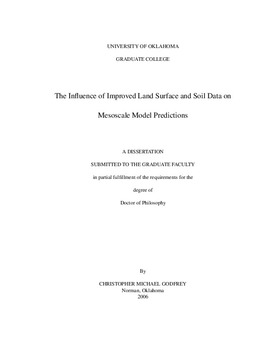| dc.contributor.advisor | Stensrud, David J., | en_US |
| dc.contributor.author | Godfrey, Christopher Michael. | en_US |
| dc.date.accessioned | 2013-08-16T12:20:29Z | |
| dc.date.available | 2013-08-16T12:20:29Z | |
| dc.date.issued | 2006 | en_US |
| dc.identifier.uri | https://hdl.handle.net/11244/1130 | |
| dc.description.abstract | A principal-component regression reveals simple relationships between latent heat flux and other available surface observations. Development of a new parameterization for evaporation from bare soil takes advantage of periods of very dry conditions observed across Oklahoma. Combining this with a new empirical canopy transpiration scheme within MM5 yields improved sensible and latent heat flux forecasts and better partitioning of the surface energy budget. Surface temperature and mixing ratio forecasts show improvement when compared with the dense network of observations from the Oklahoma Mesonet. | en_US |
| dc.description.abstract | Proper partitioning of the surface heat fluxes that drive the evolution of the planetary boundary layer in numerical weather prediction models requires an accurate specification of the initial state of the land surface. The lack of observational data for characterizing these initial conditions is arguably the most difficult aspect in the evaluation of land surface models. Routine observations of fractional vegetation coverage and leaf area index (LAI) are not available at high resolution (∼ 1 km), nor are observations of soil moisture and soil temperature. This gap in our observational capabilities seriously hampers the evaluation and improvement of land surface model parameterizations, since model errors likely relate to improper initial conditions as much as to inaccuracies in the model formulations. Two unique datasets help to overcome these difficulties. First, approximately 1-km resolution fractional vegetation coverage and LAI can be derived from biweekly maximum normalized difference vegetation index (NDVI) composites obtained from daily observations by the Advanced Very High Resolution Radiometer (AVHRR) onboard National Oceanic and Atmospheric Administration satellites. Second, the Oklahoma Mesonet supplies multiple soil temperature and soil moisture measurements at various soil depths each hour. Combined, these two unique datasets provide significantly improved initial conditions for a land surface model and allow an evaluation of the utility of the land surface model with much greater confidence and detail than previously. | en_US |
| dc.description.abstract | Simulations from The Pennsylvania State University-National Center for Atmospheric Research fifth-generation Mesoscale Model (MM5) that both include and neglect these unique land surface observations help to evaluate the value of these two data sources to land surface model initializations. The dense network of surface observations afforded by the Oklahoma Mesonet, including surface flux data derived from special sensors available at some of the Mesonet sites, provides verification of the model results. The National Centers for Environmental Prediction (NCEP) operational Eta model, which provides initial conditions for MM5, exhibits strong biases in soil temperature and severe underestimation of soil moisture compared with observations during 2004 and 2005. Therefore, the inclusion of soil temperature and soil moisture observations within MM5 simulations dramatically improves model performance. Including both soil and vegetation observations, however, tends to offset this improvement, indicating the necessity for adjustments to the land surface model physics. | en_US |
| dc.format.extent | xix, 128 leaves : | en_US |
| dc.subject | Soil moisture Measurement. | en_US |
| dc.subject | Atmospheric Sciences. | en_US |
| dc.subject | Atmospheric models Oklahoma. | en_US |
| dc.subject | Numerical weather forecasting. | en_US |
| dc.title | The influence of improved land surface and soil data on mesoscale model predictions. | en_US |
| dc.type | Thesis | en_US |
| dc.thesis.degree | Ph.D. | en_US |
| dc.thesis.degreeDiscipline | School of Meteorology | en_US |
| dc.note | Source: Dissertation Abstracts International, Volume: 67-11, Section: B, page: 6253. | en_US |
| dc.note | Adviser: David J. Stensrud. | en_US |
| ou.identifier | (UMI)AAI3242288 | en_US |
| ou.group | College of Atmospheric & Geographic Sciences::School of Meteorology | |
